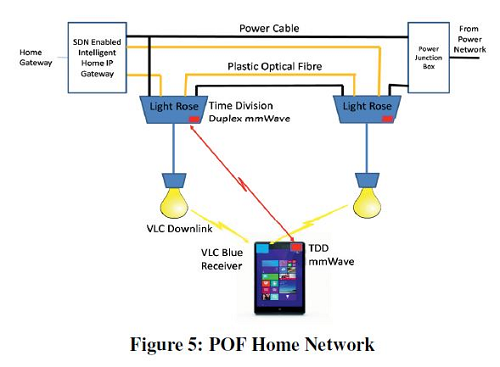
Image source: Brunel London.
By Brian Santo, contributing writer
Would reducing the energy bill by 90% make it worthwhile to replace Wi-Fi systems with a new wireless technology? Toss in better security — would you do it then? Let’s sweeten the offer with a complete lack of electromagnetic interference. Maybe you want to see the system in action first? That was just arranged. Brunel University of London just got $1 million to develop a system that will deliver those benefits through light bulbs with an added twist — low-latency connectivity through 5G networks.
Because what’s more conveniently ubiquitous than light bulbs? The idea is to modulate the intensity of LEDs at rates that would represent data at gigabits per second. Brunel London has commercial aspirations of 10 Gbps, though rates as high as 224 Gbps have been achieved in the lab at Oxford University.
The approach is called visible light communications (VLC), though in recent years, it’s picked up the moniker Li-Fi (see What is Li-Fi and how does it work?).
Li-Fi is being taken seriously by some heavy-hitters around the world. Cisco believes that Li-Fi could become an important enabler for the Internet of Things and, earlier this year, published a blog that discusses some of the permutations of Li-Fi technology. PureLiFi, a company founded to exploit the technology, began working with BT earlier this year. PureLiFi also just entered a partnership with Wipro to commercialize the technology in Asia.
Brunel London’s brainstorm is to connect Li-Fi with 5G networks to support connectivity appropriate for applications associated with the Internet of Things (IoT).
The university’s researchers envision a system that would feed data through customer premise equipment (CPE); specifically, an SDN-enabled (software-defined networking) gateway. Bulbs (or their sockets) could also embed millimeter-wave (mmWave) transmitters, complementing Li-Fi with 5G signals, if desired. Bulbs could be connected via Ethernet or fiber optic cable.
The light could be in the spectrum from 380 to 780 nm, which is the entire visible spectrum plus a bit slopping over on either end into the infrared and ultraviolet. The system works even when the light intensity is exceedingly dim.
Emissions in the mmWave spectrum would only have to go six to 10 feet or so, so the power required can be significantly reduced compared to Wi-Fi routers that are expected to push signals 150 feet or more.
That’s the basis of the security claims as well; whereas Wi-Fi signals are broadcast over large areas and radiate through walls, there’s no way to intercept low-power 5G signals generated from Li-Fi/5G light bulbs from anywhere outside the room.
When connected with low-latency 5G networks, Li-Fi opens new possibilities. John Cosmas, the professor leading the Brunel London project, said in a statement, “It will allow surgeons to perform robotic surgery from a different hospital from where the patient is located.”
As for the IoT, he said, “In general, it will enable the Internet of Control — remote control of machines and robots through the internet. So far, this has not been possible because of large and variable latencies — delays through the existing internet.”
The Li-Fi research at Brunel London is funded by Europe Horizon 2020 (an agency of the European Union that supports research and development projects) out of its $10.5 million 5G projects budget. The project is to culminate in demonstrations of the system in a supermarket in China, at the Musee de la Carte a Jouer (the Museum of Playing Cards) in Paris, and in a subway station in Madrid.
Advertisement
Learn more about Electronic Products Magazine





